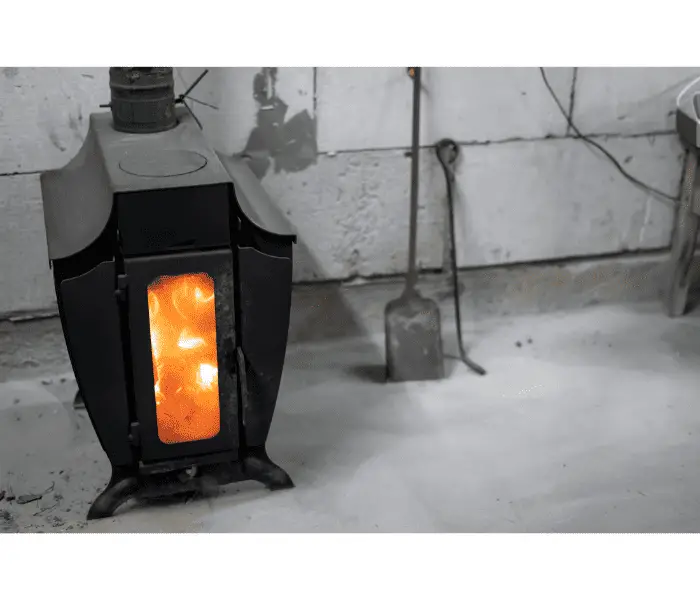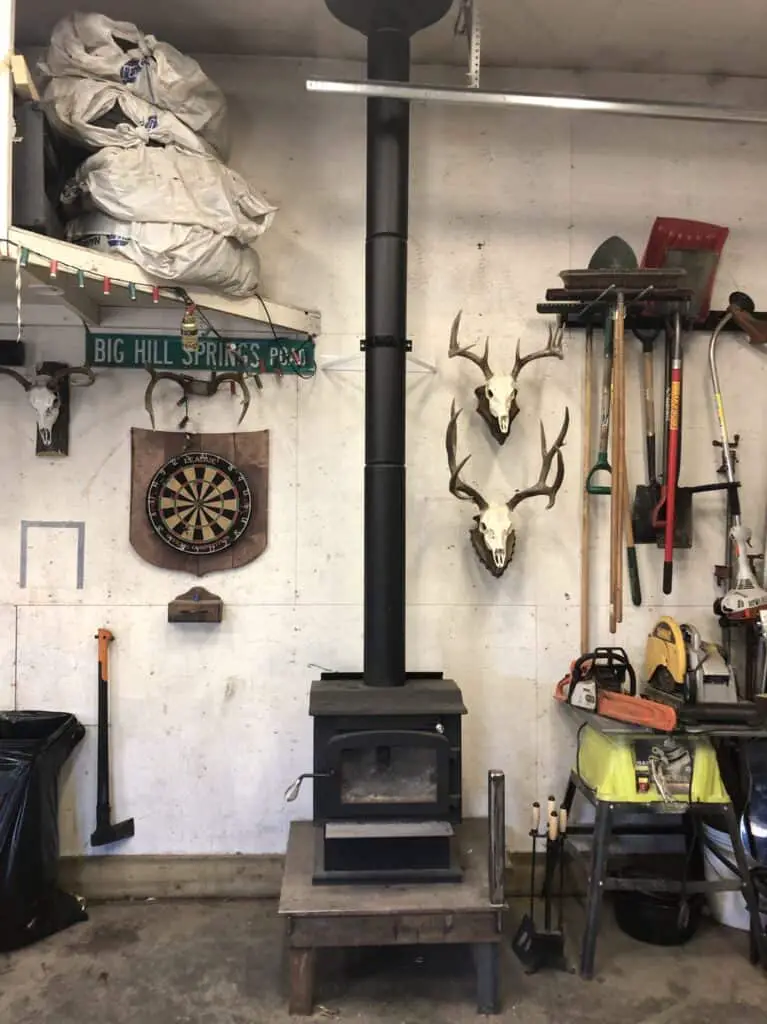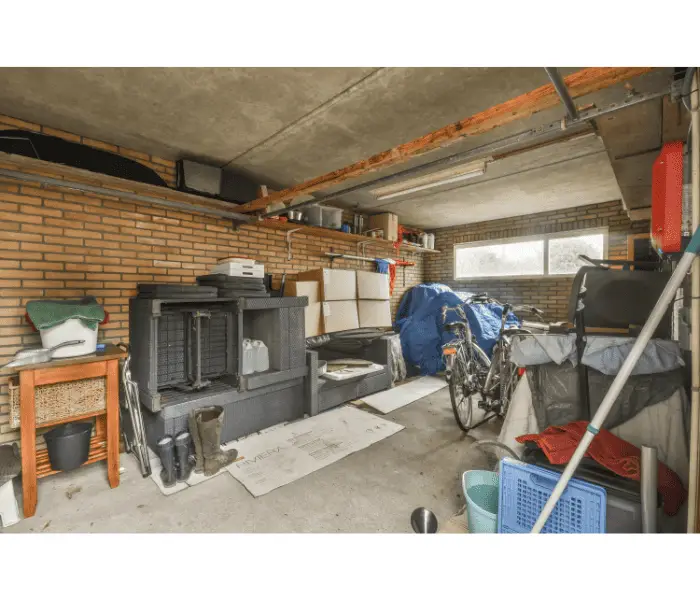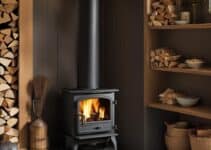A wood-burning stove is a practical and beautiful addition to any space around the home. They can be (and often are) fitted into garages, sheds, summer houses, caravans and even greenhouses.
As energy costs soar, many home owners are looking at ways to cut costs. And installing a wood stove in your detached garage could be one way to do that.
But can you put a wood stove in a detached garage? Yes, you can install a wood stove in a detached garage, but it is crucial to follow proper safety guidelines and local building codes to ensure safe operation.
But like anything, it depends on what you intend to use the stove for and factors relating to the existing specifications of your garage.
There are many things about garages that make them a great fit for wood burners. But there are definitely things to consider before you instal one.
Wood-burning or multi-fuel stoves may be a great choice for your garage and lifestyle or they may not be the best option.
So let’s look more closely at installing wood stoves in detached garages.

Can I put a Wood Stove in my Detached Garage?
Put simply, yes, you can instal a wood stove in your detached garage. The cement floor of most garages makes them an ideal base for stoves.
And depending on where you source your timber, wood stoves are often the cheapest way to heat a garage.
In some ways, detached garages are better than attached garages when it comes to installing wood stoves. But there are pros and cons.
For example, detached garages won’t retain or share the heat through the walls of your home in the way an attached garage would.
But detached garages pose less of a threat to the rest of your property in the event of a fire caused by your wood burner.

You may not need planning permission to instal a wood-burning stove in the UK but it’s always best to check with your local planning office.
Plus, there are regional and national restrictions on wood-burning stoves.
In England, you must make sure your wood burner uses smokeless fuel or emits less the 3g per hour of smoke in smoke-controlled areas.
And if you live in a listed property, you will need to consult your local authority for permission or advice about how to instal a wood burner sensitively.
Nothing beats getting a professional in if you want to instal a wood stove in your detached garage. But if you want to instal your wood burner yourself, we’ve got some tips.
How to install a wood burner in your garage:
Preliminary Measurements
Check the manufacturer’s guidelines about wall clearance and where to site your stove. Measure out a space on the concrete floor that corresponds to the manufacturer’s guidance.
Test out the stove placement to make sure your measurements are accurate.
Measure and mark out a circle in the ceiling and roof for the chimney. You may need to add approximately 10 cm to the diameter of the chimney measurement if there are combustible elements such as roof timbers around the chimney, but check the manufacturer’s guidelines.
Double-check your measurements to make sure the stove position meets or exceeds these requirements.
Cutting & Preparing the Garage Roof
Unless your roof or ceiling is made of asbestos, cut the chimney hole through the roofing of your garage around your measured outline. Make sure to clear away all the roofing material and debris.
Install the chimney collar flashing, following the chimney manufacturer’s instructions.
Double-check the chimney’s location by re-siting your stove and using a plumb bob lowered through the chimney hole. Also, recheck your wall clearance measurements.
Preparing & Cover the Garage Wall
Move the stove unit away to access the garage wall behind the stove.
Measure and mark up the position for your fire protective board on your unfinished garage wall. Position it horizontally and centred, maintaining a minimum of 1.2 meters from the centre line of the stove.
For corner installations, measure the fire-rated plasterboard extending it 1.2 meters each way from the corner behind the stove.
Offer up your fire protective board against the measured place on your garage wall and affix it with the appropriate tools needed to secure it.
Place a sheet of concrete backer board 90 cm high and centred horizontally from the centre of the stove.
Do not allow the cement backer board to extend beyond the end of the fire protective board. Attach to the wall with appropriate fixings at approximately 20 cm apart.
Attach the Stove & Construct the chimney
Position the wood stove in place and recheck the required clearances.
Connect the chimney sections. Pass the chimney through the roof opening and collar flashing and slide the base of the chimney assembly over the chimney flange on the stove top.
Attach the chimney to the stove flange according to the manufacturer’s instructions.
Fix the storm collar over the roof collar flashing. Use a waterproofing agent (such as silicone sealant or caulk) around the gap between the storm collar’s inside edge and the chimney’s vertical surface.
Attach the chimney cap and check it is fully locked onto the top of the chimney. Check the opening of the chimney flue by using the handle on the side of the chimney.
Check the Draw of Your Stove
Light a piece of newspaper in the stove firebox. Adjust the flue until the draw is at its best for your stove.
Please remember: these are guidelines only. All wood burners differ and may need a different assembly process. Likewise, garages are different and may require alternative preparation.
You should always consult the manufacturer’s guidelines before installing. And even better, hire a HETAS-approved installer.
What’s the Cost of Installing a Wood Stove in a Garage?
Costs vary depending on the cost of your stove, the chimney, tools and the fixings you use. So giving an estimate is likely to be counterproductive.
The best way around this is to suggest the breakdown of costs associated with wood stoves and their installation to help you narrow down how much you’re willing to pay.
Cost of the Stove: Stoves for garages are generally on the smaller side. So a new smaller stove may cost anywhere between £200 – £1,000 depending on the make and specifications.
Cost of Installation: This will vary between contractors, the garage, your stove and chimney set up and also the extent of the installation.
Very roughly, a full installation could cost between £1,000 – £2,000. Always ask a variety of specialists for an estimate before deciding on the best price.
If you intend to DIY your stove installation, your costs will significantly decrease.
But they are going to be dependent on the individual costs of the stove, chimney and flue system and the fire-resistant materials and tools. This could range from £500 – £1,500 or more.
What is the Best Wood Stove for a Garage?
There is no correct answer to this. Why? Because every garage is different and what you use your garage for may vary.
But smaller stoves, such as those used in caravans and canal boats, are often a good fit for garages. Although this sometimes means that the costs of the flue system will increase unless the stove is raised on a concrete plinth.
For any smaller room, like a garage, it’s best to go for a smaller capacity. This means you could choose something very small, such as the ‘tent’ stove or a Pipsqueak Stove (2.8 kW) often preferred by canal boat or tiny home owners.
Smaller wood stoves for domestic use range in capacity from 3.5 kW to 4.5 kW.
The average capacity for wood stoves used in UK homes is 5kW but they can go up to 7kW or more.
You can instal these larger capacity stoves in your garage but unless you had a specific reason that much output might be a waste of fuel.
Things to Consider Before Installing a Wood Stove in Your Garage:
As with any combustion appliance, there are fire risks relating to wood stoves even when they are located in a detached garage.
There are also methane risks, and depending on your fuel and the age and maintenance of your stove, environmental implications.
You will be required by your insurers to make sure your stove and flue are checked annually which can add to the costs.
This does, however, buy you peace of mind. Always follow the manufacturer’s guidelines when installing your wood stove or, better yet, hire a professional.
Final Thoughts
Wood stoves can be a great investment for any useable space on your property.
And as long as you instal your wood stove properly, choose the right stove for your space and get it checked regularly, your garage could become the cosiest room in your home!




